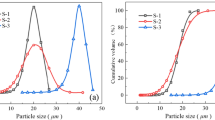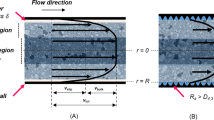Abstract
The yield stress and features of the structure of concentrated suspensions based on silica flour, with particles of average diameter around 4 μm, were investigated in terms of a phenomenological model. The yield stress of a concentrated suspension of known solid volume concentration is estimated by employing a shear-dependent maximum packing fraction Φ m which is obtained by model fitting equilibrium viscosity data, and by incorporating a first-order kinetic equation. The model proposed was examined by using several mineral suspensions in which silica flour was mixed with metal oxide particles so that microstructural features of the suspensions could be adjusted. A cocoa fat suspension was also used as a test sample having radically different chemistry. The agreement between the model prediction and independently obtained experimental evidence is acceptable. Furthermore, a qualitative explanation is obtained by a scaling analysis in an effort to relate the model parameters with the suspension structure that stems from interactions among the suspension constituents.
Similar content being viewed by others
References
Ackerson BJ (1990) Shear induced order and shear processing of model hard sphere suspensions. J Rheology 34:553–590
ASTM (1975) Annual Book of ASTM Standards, part 19: “Natural building stones; soil and rock; peat, mosses, humus”. Am Society for Testing and Materials
Buscall R (1991) Effect of long-range repulsive forces on the viscosity of concentrated latices: Comparison of experimental data with an effective hardsphere model. J Chem Soc Faraday Trans 87:1365–1370
Castillo C, Williams MC (1979) Rheology of very concentrated coal suspensions. Chem Eng Commun 3:529–547
Chang CY, Powell RL (1994) Effect of particle size distributions on the rheology of concentrated bimodal suspensions. J Rheol 38:85–98
Chang SH, Ryan ME, Gupta RK (1993) The effect of pH, ionic strength, and temperature on the rheology and stability of aqueous clay suspensions. Rheol Acta 32:263–269
Chiu WY, Don TM (1989) A study on viscosity of suspensions. J Appl Poly Sci 37:2973–2986
Chong JS, Christiansen EB, Baer AD (1971) Rheology of concentrated suspensions. J Appl Poly Sci 15:2007–2021
Collins EA, Hoffmann DJ (1979) Rheology of PVC dispersions. J Colloid Interf Sci 71:21–29
Dabak T, Yucel O (1986) Shear viscosity behaviour of highly concentrated suspensions at low and high rates. Rheol Acta 25:527–533
Doraiswamy D, Mujumdar AN, Tsao I, Beris AN, Danforth SC, Metzner AB (1991) The Cox-Merz rule extended: A theological model for concentrated suspensions and other materials with a yield stress. J Rheol 35:647–685
Eilers H (1941) Die Viskosität von Emulsionen hochviskoser Stoffe als Funktion der Konzentration. Kolloid Z Z Polym 97:313–321
Farris KJ (1968) Prediction of the viscosity of multimodal suspensions from unimodal viscosity data. Trans Soc Rheol 12:281–301
Frankel NA, Acrivos A (1967) On the viscosity of a concentrated suspension of solid spheres. Chem Eng Sci 22:847–853
Frith WJ, Mewis J, Strivens TA (1987) Rheology of concentrated suspensions: Experimental investigations. Powder Technology 51:27–34
Greene MR, Hammer DA, Olbricht WL (1994) The effect of hydrodynamic flow field on colloidal stability. J Colloid Interf Sci 167:232–246
Israelachvili JN (1985) Intermolecular and surface forces. Academic Press
Kao SV, Nielsen LE, Hill CT (1975) Rheology of concentrated suspensions of spheres. I. Effect of the liquid-solid interface. J Colloid Interf Sci 53:358–373
Krieger IM, Dougherty TJ (1959) A mechanism for non-Newtonian flow in suspensions of rigid spheres. Trans Soc Rheol 3:137–152
Krieger IM, Maron SH (1954) Direct determination of the flow curves of non-Newtonian fluids. III. Standardized treatment of viscometric data. J Appl Phys 25:72–75
Krieger IM (1972) Advances in Colloid Interface Science 3:111–136
Lee DI (1970) Packing of spheres and its effect on the viscosity of suspensions. J Paint Technol 42:579–587
Leong YK, Boger DV (1990) Surface chemistry effects on concentrated suspension rheology. J Colloid Interf Sci 136:249–256
Maron SH, Krieger IM (1960) Rheology Vol 3 (Ed. Eirich FR) Academic Press
Maron SH, Pierce PE (1956) Application of Ree-Eyring generalized flow theory to suspensions of spherical particles I. J Colloid Sci 11:80–95
Metzner AB (1985) Rheology of suspensions in polymeric liquids. J Rheol 29:739–775
Mooney M (1951) The viscosity of a concentrated suspension of spherical particles. J Coll Sci 6:162–170
Nielsen LE (1977) Polymer Rheology, Chap 7. Marcel Dekker, New York
Parks GA (1965) The isoelectric points of solid oxides, solid hydroxides, and aqueous hydroxo complex systems. Chem Rev 65:177–198
Patton TC (1979) Paint flow and pigment dispersion. John Wiley & Sons Inc
Poslinski AJ, Ryan ME, Gupta RK, Seshadri SG, Frechette FJ (1988) Rheological behaviour of filled polymeric systems I. Yield stress and shear-thinning effects. J Rheol 32:703–735. Rheological behaviour of filled polymeric systems II. The effect of a bimodal size distribution of particulates. J Rheol 32:751–771
Probstein RF, Sengun MZ, Tseng T-C (1994) Bimodal model of concentrated suspension viscosity for distributed particle sizes. J Rheol 38:811–829
Quemada D (1984) Models for rheological behaviour of concentrated disperse media under shear. Proc IX Intl Congr Rheol, Mexico, 571–582
Quemada D (1977) Rheology of concentrated disperse systems and minimum energy dissipation principle I. Viscosity-concentration relationship. Rheol Acta 16:82–94
Russel WB (1980) Review of the role of colloidal forces in the rheology of suspensions. J Rheol 24:287–317
Sengun MZ, Probstein RF (1989) Bimodal model of slurry viscosity with application to coal-slurries. Part 1. Theory and experiment. Rheol Acta 28:382–393
Shapiro AP, Probstein RF (1992) Random packings of spheres and fluidity limits of monodisperse and bidisperse suspensions. Phys Rev Lett 68:1422–1425
Thomas DG (1961) III. Laminar-flow properties of flocculated suspensions. AIChE J 7:431–437
Tsai SC, Botts D, Plouff J (1992) Effects of particle properties on the rheology of concentrated noncolloidal suspensions. J Rheol 36:1291–1332
Tsai SC, Botts D, Viers B (1989) Effects of liquid viscosity on rheology of concentrated suspensions. Part Sci Tech 7:87–95
Tsai SC, Viers B (1987) Effects of liquid polarity on rheology of noncolloidal suspensions. J Rheol 31:483–494
van der Werff JC, de Kruif CG (1989) Hard-sphere colloidal dispersions: The scaling of rheological properties with particle size, volume fraction and shear rate. J Rheol 33:421–454
Wildemuth CR, Williams MC (1984) Viscosity of suspensions modeled with a shear-dependent maximum packing fraction. Rheol Acta 23:627–635
Wildemuth CR, Williams MC (1985) A new interpretation of viscosity and yield stress in dense slurries: coal and other irregular particles. Rheol Acta 24:75–91
Author information
Authors and Affiliations
Rights and permissions
About this article
Cite this article
Zhou, J.Z.Q., Uhlherr, P.H.T. & Luo, F.T. Yield stress and maximum packing fraction of concentrated suspensions. Rheola Acta 34, 544–561 (1995). https://doi.org/10.1007/BF00712315
Received:
Accepted:
Issue Date:
DOI: https://doi.org/10.1007/BF00712315




